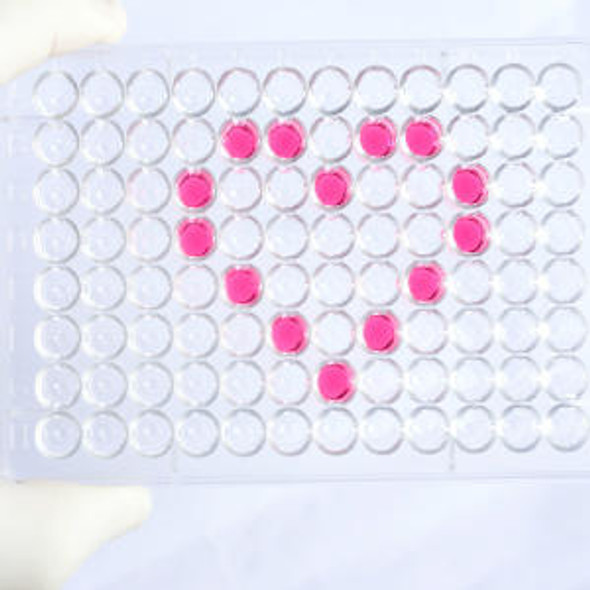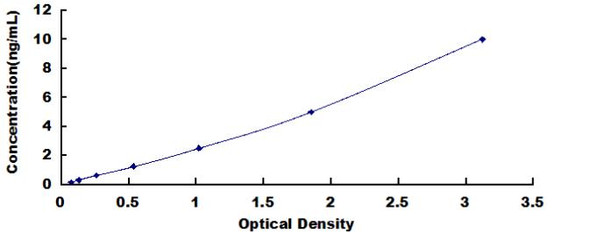Rat Cell Biology ELISA Kits 2
Rat Dual specificity mitogen-activated protein kinase kinase 1 (Map2k1) ELISA Kit
- SKU:
- RTEB0651
- Product Type:
- ELISA Kit
- Size:
- 96 Assays
- Uniprot:
- Q01986
- ELISA Type:
- Sandwich
- Reactivity:
- Rat
Description
| Product Name: | Rat Dual specificity mitogen-activated protein kinase kinase 1 (Map2k1) ELISA Kit |
| Product Code: | RTEB0651 |
| Alias: | Dual specificity mitogen-activated protein kinase kinase 1, MAP kinase kinase 1, MAPKK 1, ERK activator kinase 1, MAPK/ERK kinase 1, MEK 1, Map2k1, Mek1, Prkmk1, 2.7.12.2 |
| Uniprot: | Q01986 |
| Reactivity: | Rat |
| Range: | Please contact us for more information |
| Detection Method: | Sandwich |
| Size: | 96 Assay |
| Storage: | Please see kit components below for exact storage details |
| Note: | For research use only |
| UniProt Protein Function: | MEK1: a dual-specificity protein kinase of the STE7 kinase family. Phosphorylated and activated by Raf, Mos and Cot kinases. Phosphorylates a Thr and a Tyr residue in a Thr-Glu-Tyr sequence located in the activation loop of ERK1 and ERK2. An essential component of MAP kinase signal transduction pathways involved in many cellular processes such as proliferation, differentiation, transcription regulation and development.Protein type: Protein kinase, STE; Protein kinase, dual-specificity (non-receptor); EC 2.7.12.2; Kinase, protein; STE group; STE7 familyChromosomal Location of Human Ortholog: 15q22.1-q22.33Cellular Component: dendrite cytoplasm; Golgi apparatus; microtubule; focal adhesion; mitochondrion; endoplasmic reticulum; early endosome; perikaryon; cell cortex; cytosol; axon; perinuclear region of cytoplasm; cytoplasm; late endosome; plasma membrane; microtubule organizing center; nucleusMolecular Function: MAP kinase kinase activity; protein serine/threonine kinase activity; protein serine/threonine kinase activator activity; protein binding; Ras GTPase binding; receptor signaling protein tyrosine phosphatase activity; protein-tyrosine kinase activity; protein serine/threonine/tyrosine kinase activity; mitogen-activated protein kinase kinase kinase binding; ATP binding; protein kinase activityBiological Process: axon guidance; peptidyl-tyrosine phosphorylation; activation of MAPKK activity; nerve growth factor receptor signaling pathway; protein heterooligomerization; activation of MAPK activity; negative regulation of homotypic cell-cell adhesion; response to glucocorticoid stimulus; stress-activated MAPK cascade; cell motility involved in cell locomotion; pathogenesis; toll-like receptor 3 signaling pathway; chemotaxis; signal transduction; toll-like receptor 10 signaling pathway; neuron differentiation; toll-like receptor 5 signaling pathway; negative regulation of cell proliferation; positive regulation of RNA elongation from RNA polymerase II promoter; small GTPase mediated signal transduction; vesicle transport along microtubule; response to axon injury; cell cycle arrest; toll-like receptor 4 signaling pathway; Golgi inheritance; epidermal growth factor receptor signaling pathway; mitosis; fibroblast growth factor receptor signaling pathway; MyD88-independent toll-like receptor signaling pathway; MAPKKK cascade; melanosome transport; toll-like receptor 2 signaling pathway; MyD88-dependent toll-like receptor signaling pathway; keratinocyte differentiation; regulation of stress-activated MAPK cascade; cell proliferation; regulation of vascular smooth muscle contraction; Ras protein signal transduction; insulin receptor signaling pathway; toll-like receptor signaling pathway; innate immune response; positive regulation of Ras protein signal transduction; toll-like receptor 9 signaling pathway; response to oxidative stress; cell motility; positive regulation of cell differentiation; vascular endothelial growth factor receptor signaling pathway; positive regulation of cell migrationDisease: Noonan Syndrome 1; Cardiofaciocutaneous Syndrome 3 |
| UniProt Protein Details: | |
| NCBI Summary: | The protein encoded by this gene is a member of the dual specificity protein kinase family, which acts as a mitogen-activated protein (MAP) kinase kinase. MAP kinases, also known as extracellular signal-regulated kinases (ERKs), act as an integration point for multiple biochemical signals. This protein kinase lies upstream of MAP kinases and stimulates the enzymatic activity of MAP kinases upon wide variety of extra- and intracellular signals. As an essential component of MAP kinase signal transduction pathway, this kinase is involved in many cellular processes such as proliferation, differentiation, transcription regulation and development. [provided by RefSeq, Jul 2008] |
| UniProt Code: | Q01986 |
| NCBI GenInfo Identifier: | 5579478 |
| NCBI Gene ID: | 5604 |
| NCBI Accession: | NP_002746.1 |
| UniProt Secondary Accession: | Q01986,P31938, Q01986 |
| UniProt Related Accession: | Q01986,Q02750 |
| Molecular Weight: | 43kDa |
| NCBI Full Name: | dual specificity mitogen-activated protein kinase kinase 1 |
| NCBI Synonym Full Names: | mitogen-activated protein kinase kinase 1 |
| NCBI Official Symbol: | MAP2K1 |
| NCBI Official Synonym Symbols: | CFC3; MEK1; MKK1; MAPKK1; PRKMK1 |
| NCBI Protein Information: | dual specificity mitogen-activated protein kinase kinase 1 |
| UniProt Protein Name: | Dual specificity mitogen-activated protein kinase kinase 1 |
| UniProt Synonym Protein Names: | ERK activator kinase 1; MAPK/ERK kinase 1 |
| Protein Family: | Meiosis-specific serine/threonine-protein kinase |
| UniProt Gene Name: | MAP2K1 |
| UniProt Entry Name: | MP2K1_HUMAN |
| Component | Quantity (96 Assays) | Storage |
| ELISA Microplate (Dismountable) | 8×12 strips | -20°C |
| Lyophilized Standard | 2 | -20°C |
| Sample Diluent | 20ml | -20°C |
| Assay Diluent A | 10mL | -20°C |
| Assay Diluent B | 10mL | -20°C |
| Detection Reagent A | 120µL | -20°C |
| Detection Reagent B | 120µL | -20°C |
| Wash Buffer | 30mL | 4°C |
| Substrate | 10mL | 4°C |
| Stop Solution | 10mL | 4°C |
| Plate Sealer | 5 | - |
Other materials and equipment required:
- Microplate reader with 450 nm wavelength filter
- Multichannel Pipette, Pipette, microcentrifuge tubes and disposable pipette tips
- Incubator
- Deionized or distilled water
- Absorbent paper
- Buffer resevoir
*Note: The below protocol is a sample protocol. Protocols are specific to each batch/lot. For the correct instructions please follow the protocol included in your kit.
Allow all reagents to reach room temperature (Please do not dissolve the reagents at 37°C directly). All the reagents should be mixed thoroughly by gently swirling before pipetting. Avoid foaming. Keep appropriate numbers of strips for 1 experiment and remove extra strips from microtiter plate. Removed strips should be resealed and stored at -20°C until the kits expiry date. Prepare all reagents, working standards and samples as directed in the previous sections. Please predict the concentration before assaying. If values for these are not within the range of the standard curve, users must determine the optimal sample dilutions for their experiments. We recommend running all samples in duplicate.
| Step | |
| 1. | Add Sample: Add 100µL of Standard, Blank, or Sample per well. The blank well is added with Sample diluent. Solutions are added to the bottom of micro ELISA plate well, avoid inside wall touching and foaming as possible. Mix it gently. Cover the plate with sealer we provided. Incubate for 120 minutes at 37°C. |
| 2. | Remove the liquid from each well, don't wash. Add 100µL of Detection Reagent A working solution to each well. Cover with the Plate sealer. Gently tap the plate to ensure thorough mixing. Incubate for 1 hour at 37°C. Note: if Detection Reagent A appears cloudy warm to room temperature until solution is uniform. |
| 3. | Aspirate each well and wash, repeating the process three times. Wash by filling each well with Wash Buffer (approximately 400µL) (a squirt bottle, multi-channel pipette,manifold dispenser or automated washer are needed). Complete removal of liquid at each step is essential. After the last wash, completely remove remaining Wash Buffer by aspirating or decanting. Invert the plate and pat it against thick clean absorbent paper. |
| 4. | Add 100µL of Detection Reagent B working solution to each well. Cover with the Plate sealer. Incubate for 60 minutes at 37°C. |
| 5. | Repeat the wash process for five times as conducted in step 3. |
| 6. | Add 90µL of Substrate Solution to each well. Cover with a new Plate sealer and incubate for 10-20 minutes at 37°C. Protect the plate from light. The reaction time can be shortened or extended according to the actual color change, but this should not exceed more than 30 minutes. When apparent gradient appears in standard wells, user should terminatethe reaction. |
| 7. | Add 50µL of Stop Solution to each well. If color change does not appear uniform, gently tap the plate to ensure thorough mixing. |
| 8. | Determine the optical density (OD value) of each well at once, using a micro-plate reader set to 450 nm. User should open the micro-plate reader in advance, preheat the instrument, and set the testing parameters. |
| 9. | After experiment, store all reagents according to the specified storage temperature respectively until their expiry. |
When carrying out an ELISA assay it is important to prepare your samples in order to achieve the best possible results. Below we have a list of procedures for the preparation of samples for different sample types.
| Sample Type | Protocol |
| Serum | If using serum separator tubes, allow samples to clot for 30 minutes at room temperature. Centrifuge for 10 minutes at 1,000x g. Collect the serum fraction and assay promptly or aliquot and store the samples at -80°C. Avoid multiple freeze-thaw cycles. If serum separator tubes are not being used, allow samples to clot overnight at 2-8°C. Centrifuge for 10 minutes at 1,000x g. Remove serum and assay promptly or aliquot and store the samples at -80°C. Avoid multiple freeze-thaw cycles. |
| Plasma | Collect plasma using EDTA or heparin as an anticoagulant. Centrifuge samples at 4°C for 15 mins at 1000 × g within 30 mins of collection. Collect the plasma fraction and assay promptly or aliquot and store the samples at -80°C. Avoid multiple freeze-thaw cycles. Note: Over haemolysed samples are not suitable for use with this kit. |
| Urine & Cerebrospinal Fluid | Collect the urine (mid-stream) in a sterile container, centrifuge for 20 mins at 2000-3000 rpm. Remove supernatant and assay immediately. If any precipitation is detected, repeat the centrifugation step. A similar protocol can be used for cerebrospinal fluid. |
| Cell culture supernatant | Collect the cell culture media by pipette, followed by centrifugation at 4°C for 20 mins at 1500 rpm. Collect the clear supernatant and assay immediately. |
| Cell lysates | Solubilize cells in lysis buffer and allow to sit on ice for 30 minutes. Centrifuge tubes at 14,000 x g for 5 minutes to remove insoluble material. Aliquot the supernatant into a new tube and discard the remaining whole cell extract. Quantify total protein concentration using a total protein assay. Assay immediately or aliquot and store at ≤ -20 °C. |
| Tissue homogenates | The preparation of tissue homogenates will vary depending upon tissue type. Rinse tissue with 1X PBS to remove excess blood & homogenize in 20ml of 1X PBS (including protease inhibitors) and store overnight at ≤ -20°C. Two freeze-thaw cycles are required to break the cell membranes. To further disrupt the cell membranes you can sonicate the samples. Centrifuge homogenates for 5 mins at 5000xg. Remove the supernatant and assay immediately or aliquot and store at -20°C or -80°C. |
| Tissue lysates | Rinse tissue with PBS, cut into 1-2 mm pieces, and homogenize with a tissue homogenizer in PBS. Add an equal volume of RIPA buffer containing protease inhibitors and lyse tissues at room temperature for 30 minutes with gentle agitation. Centrifuge to remove debris. Quantify total protein concentration using a total protein assay. Assay immediately or aliquot and store at ≤ -20 °C. |
| Breast Milk | Collect milk samples and centrifuge at 10,000 x g for 60 min at 4°C. Aliquot the supernatant and assay. For long term use, store samples at -80°C. Minimize freeze/thaw cycles. |






